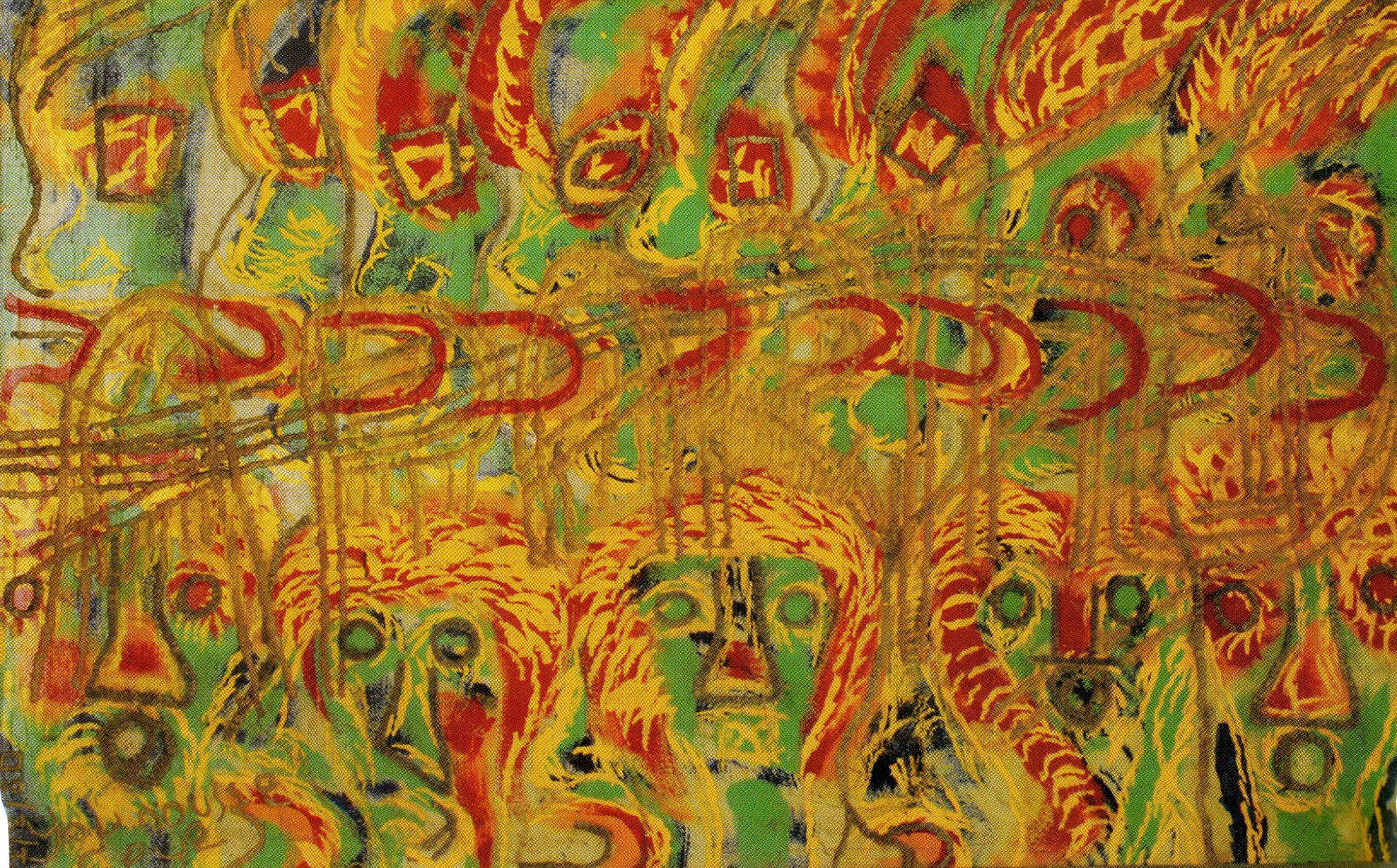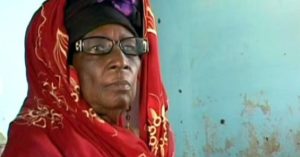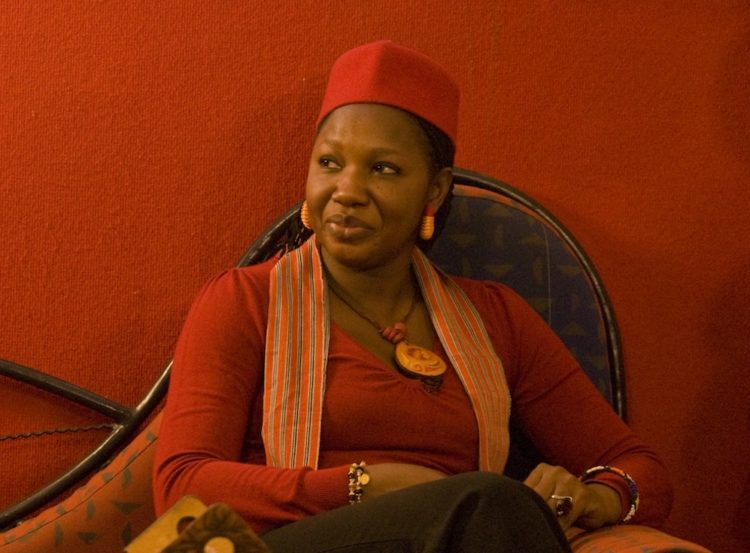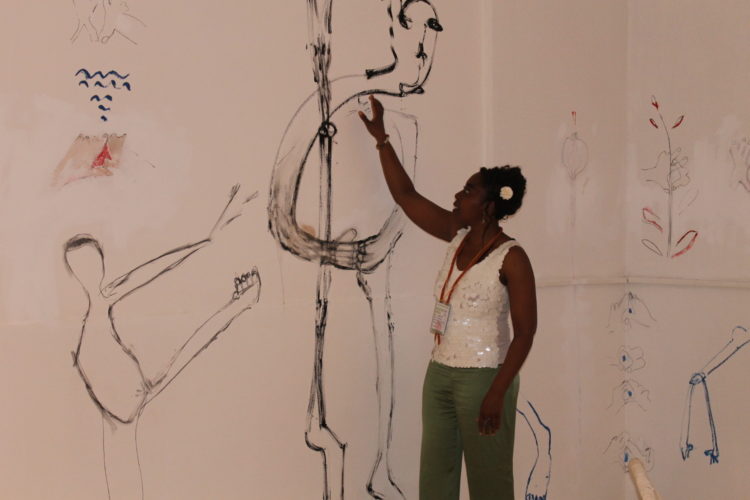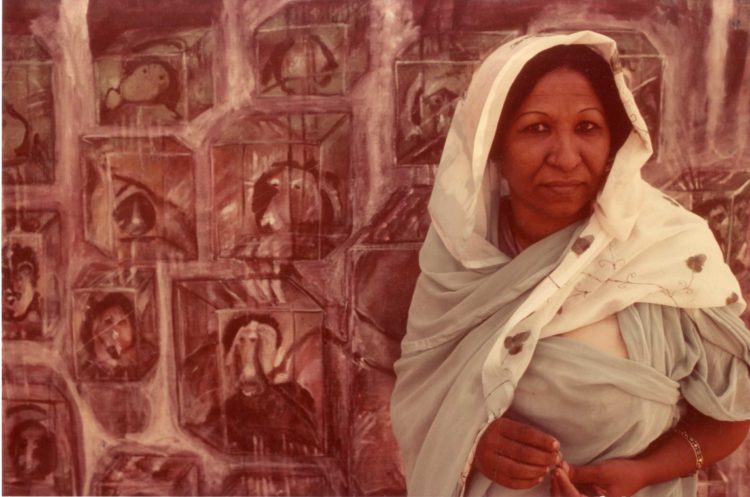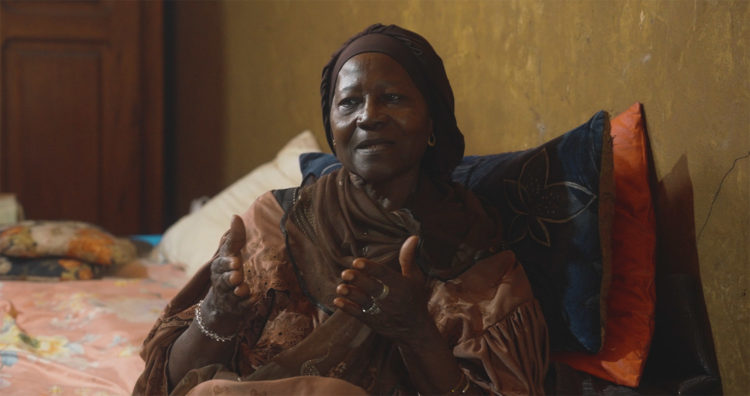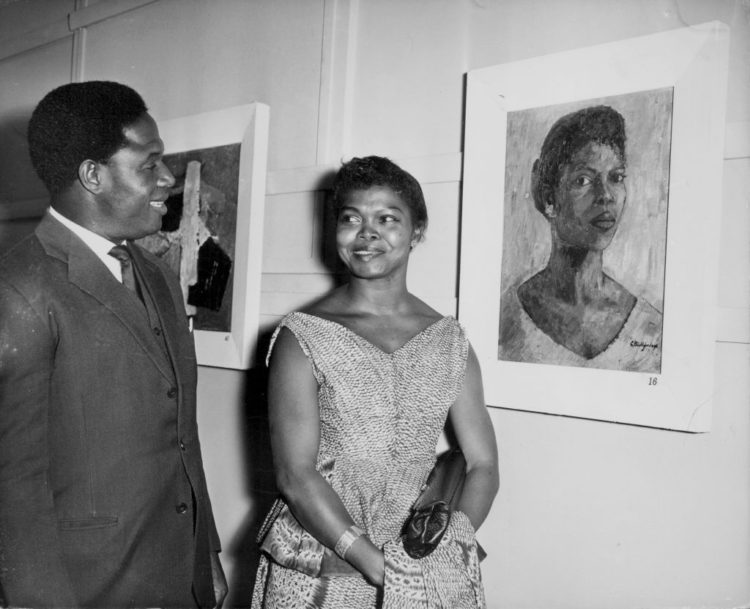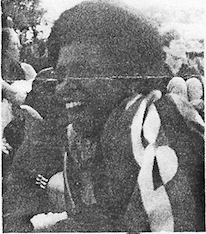Research
Younousse Seye, Contestation, 1980, reconstituted marble paint, 160 x 130 cm, © Photo: Judith Rottenburg
Senegalese women have always positioned themselves at the heart of political negotiations. Under colonial rule, influential women personalities such as Ndaté Yalla Mbodj and Aline Sitoé Diatta proved to the French military that they were a force to be reckoned with. In 1855 N. Yalla Mbodj, the Queen of the Waalo kingdom, even got together an army to counter the troops of the military expedition launched by colonial administrator Louis Faidherbe. Research shows that despite being deprived of their basic rights, women continued to take an active part in politics and regardless of social class made a significant contribution to national resistance. Those from the full status communes1 succeeded in rallying their members in 1945 to obtain the right to vote, like their French-born counterparts. The role they played during the railway strike in 1947 was glorified by the writer and filmmaker Ousmane Sembène in his 1960 novel Les Bouts de bois de Dieu [God’s Bits of Wood]. The role of artists, on the other hand, has seldom if ever been studied – although artists of both sexes undeniably played a role.
The hallmark of women artists was their creativity in terms of clothing, hairstyles, decorative arts and dance. By means of songs and poetry they succeeded in transmitting messages evoking their commitment and political beliefs, particularly regarding the rivalry between Amadou Lamine Guèye and Léopold Sédar Senghor in the late 1940s and early 1950s. Famous opera singer Yandé Codou Sène (1932-2010), for instance, showed her stalwart support for L. S. Senghor throughout his lengthy political career. To Senghor, Senegal’s first President, culture was both the root and the result of development. As soon as the country achieved international sovereignty in 1960, he launched several operations culminating in the 1st World Festival of Negro Arts in Dakar in April 1966.
WOMEN ARTISTS AND THEIR PAN-AFRICAN MILITANCY
The first post-independence generations of women artists emerged at the World Festival of Negro Arts in 1966, where they rubbed shoulders with men of culture such as L. S. Senghor, Aimé Césaire, André Malraux and filmmaker O. Sembène, who paved the way for women to break into film.
Isseu Niang (1938-2000) left school at the age of 13 to pursue her passion, dance. In 1958 she joined Fodéba Keïta’s African Ballets in Guinea and in 1959 travelled to Italy to launch her film career. When Senegal gained its independence in 1960, she chose to return and join the National Ballet in order to participate, within her own field, in the construction of her country. She acted in several films by politically committed directors such as O. Sembène, Djibril Diop Mambéty and Mahama Johnson Traoré.2
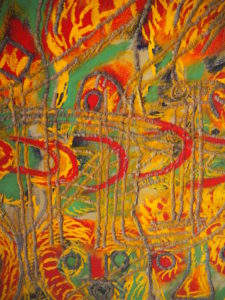
Younousse Seye, Contestation (detail), 1980, reconstituted marble paint, 160 x 130 cm, © Photo: Judith Rottenburg
Self-made woman Younousse Seye (born 1940) made a name for herself as an actress during the Pan-African Festival in Dakar in 1966. Despite her acting roles in several films by O. Sembène3, however, she really gained renown through her paintings. According to researcher Judith Rottenburg,4 Y. Seye displayed her political commitment as early as 1977 thanks to a major solo exhibition in Dakar. She featured 107 paintings, addressing the issue of apartheid in particular and raising the question of African solidarity. She gave form to her defence of African culture by using cowrie shells and one of her masterpieces, La Contestation (1980), in reconstituted marble, bears the inscription ‘Apartheid’. Through her artworks Y. Seye rolls out her personal vision of Africa and never loses an opportunity to give voice to her political views and draw attention to the place of women in society.
Following the 1st World Festival of Negro Arts, Safi Faye (born 1943), who initially trained as a teacher, made a life-changing decision. She moved to Paris to study ethnology at the École des Hautes Études en Sciences Sociales (EHESS) and filmmaking at the Louis-Lumière School, in order to tackle the concept of Africanity, thereby demonstrating an unmitigated commitment to her culture. Her films – such as Kaddu Beykat [Letter from My Village] (1975); Selbé et tant d’autres (1982) and Mossane (1996) – drew their themes from the Serer community while also condemning the exploitation and situation of women, not to mention forced marriages.
A COMMITMENT TO SOCIAL AND WOMEN’S ISSUES
These artists were not the only ones to highlight the thorny question of social and women’s issues in Senegal. Anta Germaine Gaye (born 1953)5– who has been acclaimed for her glass-painted portraits – reckons that women not only need to stake their position and give voice to their suffering, they also have a duty to ensure that their inner beauty is given its due. Filmmaker Fabineta Diop (born 1972), who initially worked as Moussa Touré’s assistant, recently directed a documentary on the subject of marriage. Through Dakarese women’s first-hand accounts of marriage, polygamy and divorce, Mariage et ménage (2001) addresses the shackles and silence imposed on women by tradition.
The 2000s saw artists taking a stand for women’s rights. Director Diabou Bessane was one of them. In her film Les Mamans de l’indépendance, released in 2011, she aimed to rehabilitate the women who had taken part in the political fight for independence in the late 1950s, founding the seminal Union des femmes au Sénégal (UFS) and Union des femmes de l’Ouest africain (UFOA).
INVOLVEMENT IN THE STRUGGLE FOR GENDER EQUALITY IN SENEGAL
The 2000s were a coming of age moment in a citizenship process that led a number of social groups, in particular women and the younger generation, to rally together in favour of social change. This brought about the first change of political governance since independence. It provided a framework for women to overturn the established order and obtain a law introducing full parity. A vast movement, supported by artists, was set in motion, featuring community organisations, unions and political parties. In this struggle for gender equality, a number of men and women decided to join the women’s social movement through the Caucus of Women Leaders for Parity. Three painters made a name for themselves during this process: Senegalese artists Fatou Kiné Diakhaté (born 1967) and A. G. Gaye and Mauritanian artist Malika Diagana (born 1982), who all put up works for auction in order to help the cause.
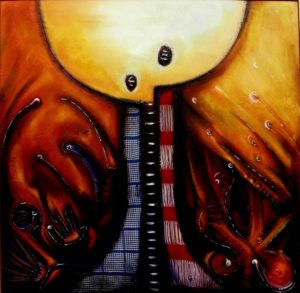
Fatou Kiné Diakhaté, L’Égalité des chances, 2009, oil on canvas and mixed media, 100 x 100 cm, offered to women’s movement Caucus, IFAN Gender and research Laboratory
F. Kiné Diakhaté is the one who has become most involved in the struggle for gender parity. She plays an active part in a range of manifestations targeting social issues, gets involved in petitions and lobbying and has painted a canvas entitled Égalité des chances [Equal Opportunities] (2009). She has also produced two magnificent trophies made out of calabash gourds which were awarded to the press groups that had been most pro-active in expressing their support for the bill to introduce parity and equality between men and women. All of which proves the commitment of an artist who has used her creations to further the cause.
The political sea change that came about in Senegal in the year 2000 owes a lot to the country’s artists. Regardless of their sex, they were instrumental in bringing about a transformation in the collective imagination, thereby overturning forty years of Socialist rule.
As regards the women’s rights movement, it would appear that artists are also likely to play a role in the struggles ahead. During a meeting of women leaders on 14th March 2009 at the Théodore-Monod Museum of African Art, which houses the Fundamental Institute of Black Africa (IFAN) of Cheikh-Anta-Diop University, prominent figures such as Mame Faguèye Ba (fashion stylist) and A. G. Gaye illustrated through their own career paths and commitment how the feminist movement can only benefit from joining forces with artists, who are able to convey, in a different and even more far-reaching way, their common message in favour of equal rights.6 These women have proved their ability to trigger revolutions. To make their voices heard, they have had to stand their ground in the face of opposition from their families and from a society that condemned their choices. To achieve this, they required courage, determination and an awe-inspiring inner strength. At a time when social mobilisation is dwindling in Senegal, it would seem that artists are currently best equipped to take on the struggle for a global transformation of society. They may well be the launch pad for women’s revolutions to come.
Dakar, Gorée, Rufisque and Saint-Louis were the first full status communes to be created by the French in Senegal, in the late nineteenth century. This status granted limited citizenship to its inhabitants, which deputy Blaise Diagne (the first Black deputy) succeeded in extending to full French citizenship in September 1916.
2
Liberté 1 (1962) by Yves Ciampi; Le Bracelet de bronze (1973) by Tidiane Aw; Mandabi (Le Mandat, 1968) and Guerlwaar (1992) by O. Sembène; Diègue-Bi (The Young Woman, 1970) by M. J. Traoré; Hyènes (1992) by D. D. Mambéty. She also appeared in Mossane (1996) by S. Faye, in which she played the mother; TGV (1997) by M. Touré; Même le vent (1999), the first part of Laurence Attali’s La Trilogie des Amours; Une femme pour Souleymane (2000) by Dyana Gaye.
3
La Noire de…, which won the 1st World Festival of Negro Arts award in 1966; Mandabi (Le Mandat, 1968), which received the International Critics prize at the Venice Festival; Xala (1976) and Faat-Kiné (2000).
4
Post-doctoral researcher for the project Developing Theatre: Building Expert Networks for Theatre in Emerging Countries after 1945.
5
Mbow Penda, ‘Femmes et images: la production culturelle chez les Africaines’, Clio. Femmes, genre, histoire, 2004, no. 19, https://journals.openedition.org/clio/648?lang=en#tocfrom1n1, consulted on 25th September 2021.
6
Sarr, Fatou (ed.), Femmes leaders: échanges intergénérationnels, Dakar, laboratoire Genre et Recherche scientifique, IFAN, université Cheikh-Anta-Diop, 2012.
Fatou Sow Sarr, who holds a PhD in anthropology and sociology, is a senior lecturer at IFAN, at Cheikh-Anta-Diop University in Dakar, where she heads the scientific research laboratory on gender and science, which she created in 2004. Before moving to Dakar in 1999, she taught at Namur University in Belgium. Professor Fatou Sow Sarr teaches in a number of European universities. She is a gender specialist for United Nations agencies in around twenty African and Caribbean countries. As well as making a valuable contribution to women’s economic and political empowerment she is President of the African Network for Support to Women’s Entrepreneurship (RASEF) and Coordinator of the Caucus of Women Leaders for Parity, which with the help of artists such as Fatou Kiné Diakhaté, Anta Germaine Gaye and Kalidou Kassé, has proved instrumental in introducing parity to Senegal. Fatou Sow Sarr also intervenes within international organisations: she is a member of the International Monetary Fund for Sub-Saharan Africa and the executive committee for the Forum of African Women Educationalists (FAWE/Nairobi) and is also on the advisory board for research and development at the World Health Organisation.
Fatou Sow Sarr, "Women artists and their role in the political struggles of Senegal." In , . URL : https://awarewomenartists.com/en/magazine/la-place-des-artistes-femmes-dans-les-luttes-politiques-au-senegal/. Accessed 1 July 2025
